

S Information for Adult Learners and Workers : Going Back to College. More and more adults are choosing to attend college, either as first-time students or as returning students completing a degree begun earlier in life.
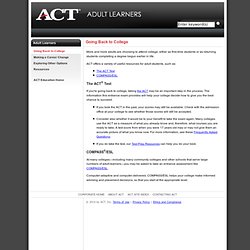
ACT offers a variety of useful resources for adult students, such as: The ACT® Test If you're going back to college, taking the ACT may be an important step in the process. The information this entrance exam provides will help your college decide how to give you the best chance to succeed. If you took the ACT in the past, your scores may still be available. At many colleges—including many community colleges and other schools that serve large numbers of adult learners—you may be asked to take an entrance assessment like COMPASS/ESL. Computer-adaptive and computer-delivered, COMPASS/ESL helps your college make informed advising and placement decisions, so that you start at the appropriate level. Software Engineering, Not Computer Science.
“A scientist builds in order to learn; an engineer learns in order to build.
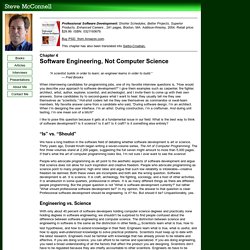
. ” — Fred Brooks When interviewing candidates for programming jobs, one of my favorite interview questions is, “How would you describe your approach to software development?” Small business. Portici di Sottoripa, Genova, Italy Galleries tend to form clusters of small business owners over time.
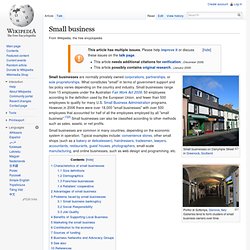
Small businesses are normally privately owned corporations, partnerships, or sole proprietorships. What constitutes "small" in terms of government support and tax policy varies depending on the country and industry. Small businesses range from 15 employees under the Australian Fair Work Act 2009, 50 employees according to the definition used by the European Union, and fewer than 500 employees to qualify for many U.S. Small Business Administration programs. However,in 2006 there were over 18,000 "small businesses" with over 500 employees that accounted for half of all the employees employed by all "small business".[1][2] Small businesses can also be classified according to other methods such as sales, assets, or net profits.
Small businesses are common in many countries, depending on the economic system in operation. Web application development. Web application development is the process and practice of developing web applications.

Risk[edit] Just as with a traditional desktop application, web applications have varying levels of risk. A personal home page is much less risky than, for example, a stock trading web site. For some projects security, software bugs, etc. are major issues. Graphic design. Graphic design is the methodology of visual communication, and problem-solving through the use of type, space and image.
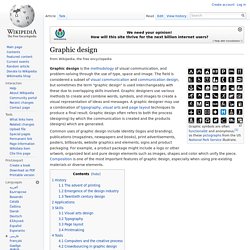
The field is considered a subset of visual communication and communication design, but sometimes the term "graphic design" is used interchangeably with these due to overlapping skills involved. Graphic designers use various methods to create and combine words, symbols, and images to create a visual representation of ideas and messages. A graphic designer may use a combination of typography, visual arts and page layout techniques to produce a final result. Graphic design often refers to both the process (designing) by which the communication is created and the products (designs) which are generated. History[edit] Page from the Book of Kells: Folio 114v, Decorated text. The advent of printing[edit] During the Tang Dynasty (618–907) between the 7th and 9th century AD, wood blocks were cut to print on textiles and later to reproduce Buddhist texts.
Consultant. A consultant (from Latin: consultare "to discuss") is a professional who provides professional or expert advice[1] in a particular area such as security (electronic or physical), management, accountancy, law, human resources, marketing (and public relations), finance, engineering, or any of many other specialized fields.
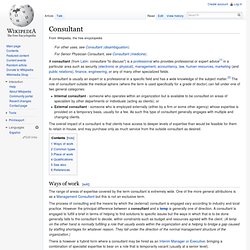
A consultant is usually an expert or a professional in a specific field and has a wide knowledge of the subject matter.[2] The role of consultant outside the medical sphere (where the term is used specifically for a grade of doctor) can fall under one of two general categories: Internal consultant - someone who operates within an organization but is available to be consulted on areas of specialism by other departments or individuals (acting as clients); orExternal consultant - someone who is employed externally (either by a firm or some other agency) whose expertise is provided on a temporary basis, usually for a fee. Ways of work[edit] Common types[edit] Information technology consulting. Information technology consulting (also called IT consulting, computer consultancy, computing consultancy, technology consulting, business and technology services or IT advisory) is a field that focuses on advising businesses on how best to use information technology to meet their business objectives.
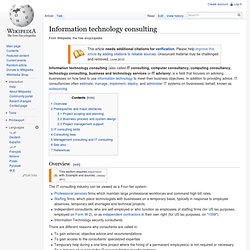
In addition to providing advice, IT consultancies often estimate, manage, implement, deploy, and administer IT systems on businesses' behalf, known as outsourcing. Overview[edit] The IT consulting industry can be viewed as a Four-tier system: There are different reasons why consultants are called in: To gain external, objective advice and recommendationsTo gain access to the consultants' specialized expertiseTemporary help during a one-time project where the hiring of a permanent employee(s) is not required or necessaryTo outsource all or part of the IT services from a specific company.